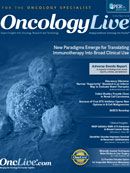Publication
Article
Oncology Live®
Discovery Dilemma: Narrow "Superiority" Standard Is an Inferior Way to Evaluate Novel Therapies
Author(s):
The lack of documented superiority in a given randomized oncology trial may not indicate the absence of clinical utility but rather the presence of equivalent favorable activity for each of the two agents.
Maurie Markman, MD
Editor-in-Chief of OncologyLive
Senior vice president for Clinical Affairs and National Director for Medical Oncology Cancer Treatment Centers of America, Eastern Regional Medical Center
The role of the randomized phase III trial in the oncology drug development paradigm is well established. However, the traditional requirement that all new antineoplastic drugs be examined in such a study setting has been appropriately challenged, and two examples of the impediments that this imperative can create serve to support those concerns.
Objections to the mantra associated with mandating phase III trials include: (1) limited patient numbers in unique subsets, particularly in the rapidly evolving arena of molecularly based oncology care; (2) the profound and rapidly worsening inefficiency in the initiation, conduct, and completion of cancer clinical trials where a distressingly large proportion of studies are never finished or reported in the peer-reviewed literature; (3) the increasingly recognized bias in studies with industry sponsorship; and (4) the highly questionable relationship between trial results and the delivery of cancer care in the “real world” where older age patients and patients with comorbidities are the norm and not the exception (as is not the case in the vast majority of clinical trials).
As unsettling as each of these contentions is to the future relevance of traditional randomized trials in the oncology sphere, there is another concerning factor that has received little attention to date in this accelerating debate: If a novel agent demonstrates evidence of clinical activity in an area of unmet need, why should development of that emerging therapy be stymied if it does not meet a narrow definition of “superiority” in a comparative, randomized trial with a standard therapy?
Consider, for example, a report about the somewhat surprising activity of cediranib, a small-molecule inhibitor of vascular endothelial growth factor receptor (VEGFR), against alveolar soft part sarcoma, a highly vascular malignancy that comprises less than 1% of all soft-tissue sarcomas.1 Since existing therapy for this cancer is largely ineffective, a 35% objective response rate (partial responses) among 43 evaluable patients who participated in this phase II trial must be considered an impressive performance. Overall, 84% of patients in this trial demonstrated either a response or stable disease at 24 weeks’ follow-up.
These data are themselves quite interesting, and Kummar et al note that a randomized phase II registration trial comparing cediranib with another VEGFR inhibitor is being conducted, laying the groundwork for an FDA application.1 But how will this randomized study be interpreted if the results are deemed negative concerning whether cediranib makes a favorable impact on a survival outcome? Does this mean the novel agent is ineffective in this setting or that both VEGFR inhibitors are biologically and clinically active? If a statistically significant difference is not observed, does this mean the experimental agent is not superior or does it mean that the sample size was inadequate to answer the question? If a crossover is permitted—which would be ethically mandated based on the highly favorable results in the nonrandomized phase II experience—and an improvement in overall survival is not observed as a consequence of participant crossovers, does this mean cediranib is ineffective? Would it be effective if given either before or even following an alternative VEGFR inhibitor?
The seriousness of the fundamental issue of the “superiority” standard is highlighted by the results of a previously reported randomized phase II trial that compared the experimental agent olaparib with pegylated liposomal doxorubicin in the second-line treatment of patients with ovarian cancer with a germline BRCA1/2 mutation.2
Several previous studies had revealed remarkably impressive single-agent activity for olaparib, which inhibits poly(ADP-ribose) polymerase (PARP), in this clinical setting, and yet in this randomized trial there was no difference in progression-free or overall survival between this drug and the standard cytotoxic agent.2 This result was interpreted by many in the oncology arena, and apparently governmental drug regulatory agencies, as a “negative” study, yet this conclusion must be vigorously challenged.
The lack of superiority for olaparib compared with pegylated liposomal doxorubicin may simply indicate the favorable biological and clinical activity of the cytotoxic drug in this particular clinical setting rather than the lack of utility for the novel targeted agent. Most importantly, the study is not helpful in providing any information as to the utility of employing these two possibly highly active drugs in sequence. Therefore, how can one justify the conclusion that this was a “negative” study?
In summary, the lack of documented superiority in a given randomized oncology trial may not indicate the absence of clinical utility but rather the presence of equivalent favorable activity for each of the two agents. If this interpretation were correct, the rational approach to optimize clinical outcomes would be to learn to use both strategies effectively (eg, sequential, combination delivery) rather than to tragically discard the novel drug due to profoundly inappropriate claims of “ineffectiveness.”
Maurie Markman, MD, editor-in-chief, is senior vice president for Clinical Affairs and national director for Medical Oncology at Cancer Treatment Centers of America. maurie.markman@ctca-hope.com
References
- Kummar S, Allen D, Monks A, et al. Cediranib for metastatic alveolar soft part sarcoma. . 2013;31(18):2296-2302.
- Kaye SB, Lubinski J, Matulonis U, et al. Phase II, open-label, randomized, multicenter study comparing the efficacy and safety of olaparib, a poly (ADP-ribose) polymerase inhibitor, and pegylated liposomal doxorubicin in patients with BRCA1 or BRCA2 mutations and recurrent ovarian cancer [published online December 27, 2011].










